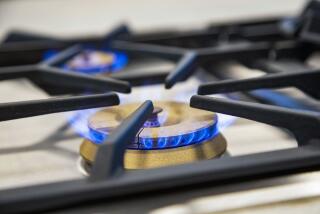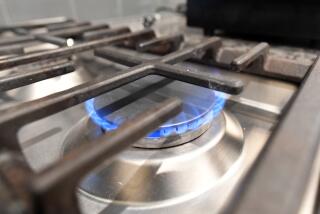This High-Tech Stove Wonât Catch Fire With Cavemen
I used to get a pretty fair kick out of a commercial that ran on TV several years ago that touted electric cooking. Electric cooktops in your kitchen were superior to gas, the ad said, because they employed a modern source of energy that enabled you to cook without using fire. Fire, it was asserted, was the method our ancestors the cave-dwellers used and was hardly appropriate to the disco age.
So everyone who was trendy enough to have a leisure suit hanging in his closet dashed right out and got an electric cooktop or range and felt better about it.
If he tried to cook on it, though (unlikely; mid-1970s disco gods were not domestic), he would have found it inconvenient, imprecise and an invitation to disaster if, say, he turned off the heat under a boiling pot and left the pot sitting on the burner. And did you ever try to thoroughly clean a set of those hideous electric coils after one of those inevitable boil-overs?
Not to be denied, however, the electric cooktop manufacturers came up with a partial solution: electric burners sealed under decorative glass. This eliminated the cleaning problem, but the glass often would scratch, the pot would still boil over if left unattended, and there was a strong temptation to believe that the glass was not hot when it was and do something idiotic like lean on it. But it looked fairly contemporary.
Meanwhile, everyone who laughed derisive laughter at the caveman cooking commercial was happily knocking together great meals on their gas cooktops, controlling those little flames with pinpoint accuracy, never having to guess whether the thing was on and performing only a small penance by having to gingerly clean up the occasional spill that seeped down into the burner area. The electric burner people had long since given up and sent out for Chinese.
I found that it was possible to turn into a true gas-cooking fanatic. I began hanging around restaurants, such as the now sadly defunct Vanessiâs in San Francisco, where it was possible to watch great chefs joyfully sauteing and producing the occasional thumping flash fire up into the range hood.
It would be bliss, I thought, to one day own one of those big, gleaming commercial-grade gas cook stoves made by Wolf and enshrine it in a kitchen the size of the Dodger Stadium infield. A Wolf stove, I knew, was the absolute benchmark of the truly committed cook. Sure, it was built like a Bradley Fighting Vehicle, but so what? You could roast a buffalo on it. There was nothing that came close to being that sexy in the electric line.
It makes my heart shrivel to say it, but that may have changed. Thereâs a type of cooktop on the market today that looks like something from the galley of the Starship Enterprise and, if Colleen Langston is right, cooks like it.
The cooktop, manufactured by Induction Range Inc., of San Fernando, is known as the Fasar and cooks through the use of magnetic induction. Langston, who is the national vice president of the Society of Certified Kitchen Designers (she also runs Euro-American Kitchens and Baths in Santa Ana Heights), said the âmagneticâ part of the designation is literal.
The cooktop is powered by an electric motor that is generally installed in the cabinet beneath the burners, which are covered in scratch-resistant glass. When a burner is turned on, the heat energy is magnetically inducted into the metal of the cooking utensil placed on top of the glass.
The glass itself doesnât become hot, said Langston, but the pot or pan does. And the heat is transferred only if there is a piece of metal sitting on top of the glass. When the pot or pan is removed, no heat is transferred. It is possible, she said, to put your hand on top of one of the burners and feel little or no heat, even when the burners are turned on. It takes magnetically attractive metal to pull the heat through.
âTake the pot off,â she said, âand it breaks the circuit.â
Also, she said, the heat goes on and off almost as quickly as a flame. And if you have tinkerers around your kitchen who are prone to fiddle with the settings of your burners, there is a feature on the Fasar that enables you to encode and lock in burner settings.
There are two things, Langston believes, that are standing in the way of a wide acceptance of magnetic induction: cost and technology. A home kitchen-sized Fasar unit, she said, runs around $3,500. And, she added, some people tend to be suspicious of spiffy technology in something that would replace something as basic as a flame.
Also, she said, âthere are people who cook, and there are people who donât.â Which is a simple way of saying that if you eat out a lot, youâre likely to buy a cooktop or a range that looks fairly NASA-like but is about as practical for real cooking as flint and steel. And, if you think of the kitchen as the room where you really live, youâre likely to lust after a top-of-the-line Wolf stove, which she said can run about $5,000.
Call me Neanderthal, but my choice is clear. I love âStar Trekâ (new version), I love my computer and I think of the fax machine as a gift from God. But when I cook I want to see fire, just like my great-grandfather (to the tenth power) did.
Really, I could go on and on about it. But I have to go turn the buffalo.
More to Read
Eat your way across L.A.
Get our weekly Tasting Notes newsletter for reviews, news and more.
You may occasionally receive promotional content from the Los Angeles Times.










